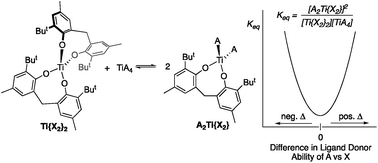当前位置:
X-MOL 学术
›
Faraday Discuss.
›
论文详情
Our official English website, www.x-mol.net, welcomes your
feedback! (Note: you will need to create a separate account there.)
Catalyst design insights from modelling a titanium-catalyzed multicomponent reaction.
Faraday Discussions ( IF 3.3 ) Pub Date : 2019-12-02 , DOI: 10.1039/c9fd00033j Kelly E Aldrich 1 , Dhwani Kansal , Aaron L Odom
Faraday Discussions ( IF 3.3 ) Pub Date : 2019-12-02 , DOI: 10.1039/c9fd00033j Kelly E Aldrich 1 , Dhwani Kansal , Aaron L Odom
Affiliation

|
High oxidation state transition metal catalysis touches our daily lives through bulk chemical production, e.g. olefin polymerization, and through specialty chemical reactions common in organic synthesis, e.g. the Sharpless asymmetric epoxidation and olefin dihydroxylation. Our group has been expanding the reaction chemistry of titanium(iv) to produce a host of nitrogen-based heterocycles via multicomponent coupling reactions. One such multicomponent coupling reaction discovered in our laboratory is iminoamination, involving an amine, an alkyne, and an isonitrile. However, the experimental modeling of high oxidation state reactions lags far behind that of low oxidation state systems, where a great deal is known about ligands, their donor properties and how their structures affect catalysis. As a result, we have developed an experimental method for determining the donor abilities of anionic ligands on high oxidation state systems, which is based on the chromium(vi) nitride system NCr(NiPr2)2X, where X = the ligand being interrogated. The parameters obtained are simply called ligand donor parameters (LDP). In this contribution, a detailed optimization of the Ti(NMe2)2(dpm)-catalyzed iminoamination reaction was carried out, where dpm = 5,5-dimethyldipyrrolylmethane. During the course of these studies, dimeric {Ti(μ-N-tolyl)(dpm)}2 was isolated, which is proposed as the resting state of the catalyst. To destabilize this resting state, a more electron-rich bis(aryloxide) catalyst system was investigated. The more electron-rich system is somewhat more active for iminoamination under some conditions; however, the catalyst is prone to disproportionation. A study of heteroleptic titanium complexes revealed that the disproportionation equilibrium constant can be effectively modeled as a function of the square of the difference in LDP between the ligands, (ΔLDP)2. Using this methodology, one can estimate the stability of titanium complexes toward disproportionation.
中文翻译:

通过对钛催化的多组分反应进行建模,可以了解催化剂的设计见解。
高氧化态过渡金属催化通过批量化学生产(例如烯烃聚合)和有机合成中常见的特殊化学反应(例如Sharpless不对称环氧化和烯烃二羟基化)触及我们的日常生活。我们的小组一直在扩大钛(iv)的反应化学,以通过多组分偶联反应生产大量基于氮的杂环。在我们的实验室中发现的一种此类多组分偶联反应是亚胺化,涉及胺,炔和异腈。然而,高氧化态反应的实验模型远远落后于低氧化态系统的模型,在低氧化态系统中,关于配体,其给体性质以及其结构如何影响催化作用的知识很多。因此,我们开发了一种用于确定高氧化态系统上阴离子配体供体能力的实验方法,该方法基于氮化铬(vi)系NCr(NiPr2)2X,其中X =被询问的配体。获得的参数简称为配体供体参数(LDP)。在此贡献中,进行了Ti(NMe2)2(dpm)催化的亚氨基化反应的详细优化,其中dpm = 5,5-二甲基二吡咯烷基甲烷。在这些研究过程中,分离出二聚体{Ti(μ-N-甲苯基)(dpm)} 2,这被认为是催化剂的静止状态。为了破坏该静止状态的稳定性,研究了更富电子的双(芳氧基)催化剂体系。在某些条件下,电子含量更高的系统对于亚氨基化反应更具活性。然而,催化剂易于歧化。对杂合钛配合物的研究表明,歧化平衡常数可以根据配体之间的LDP差异平方(ΔLDP)2进行建模。使用这种方法,可以估计钛配合物对歧化的稳定性。
更新日期:2019-12-04
中文翻译:

通过对钛催化的多组分反应进行建模,可以了解催化剂的设计见解。
高氧化态过渡金属催化通过批量化学生产(例如烯烃聚合)和有机合成中常见的特殊化学反应(例如Sharpless不对称环氧化和烯烃二羟基化)触及我们的日常生活。我们的小组一直在扩大钛(iv)的反应化学,以通过多组分偶联反应生产大量基于氮的杂环。在我们的实验室中发现的一种此类多组分偶联反应是亚胺化,涉及胺,炔和异腈。然而,高氧化态反应的实验模型远远落后于低氧化态系统的模型,在低氧化态系统中,关于配体,其给体性质以及其结构如何影响催化作用的知识很多。因此,我们开发了一种用于确定高氧化态系统上阴离子配体供体能力的实验方法,该方法基于氮化铬(vi)系NCr(NiPr2)2X,其中X =被询问的配体。获得的参数简称为配体供体参数(LDP)。在此贡献中,进行了Ti(NMe2)2(dpm)催化的亚氨基化反应的详细优化,其中dpm = 5,5-二甲基二吡咯烷基甲烷。在这些研究过程中,分离出二聚体{Ti(μ-N-甲苯基)(dpm)} 2,这被认为是催化剂的静止状态。为了破坏该静止状态的稳定性,研究了更富电子的双(芳氧基)催化剂体系。在某些条件下,电子含量更高的系统对于亚氨基化反应更具活性。然而,催化剂易于歧化。对杂合钛配合物的研究表明,歧化平衡常数可以根据配体之间的LDP差异平方(ΔLDP)2进行建模。使用这种方法,可以估计钛配合物对歧化的稳定性。











































 京公网安备 11010802027423号
京公网安备 11010802027423号